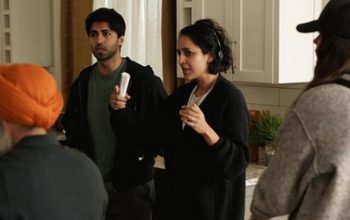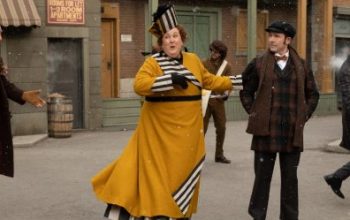It’s almost time for a new season of Vikings, and before tonight’s Season 3 premiere, Clive Standen (Rollo) and Kevin Durand (new character, Harbard) take us behind the shield wall and tease what’s coming up! There are some mild spoilers below, so be aware as you read on.
Clive, where is Rollo at when Season 3 begins, and what can you tell us about the challenges he faces in the coming season?
Clive Standen: At the beginning of Season 3, he’s still running away from his demons. At the beginning of Season 2, he makes that monumental decision to betray his brother, and spends the rest of the season trying to get back into Ragnar’s good graces. At the end of Season 2, we leave him after the raid from Horik, and he’s injured and Siggy’s nursing him. Siggy and Rollo have a relationship that’s tempestuous at the best of times. It was a marriage of convenience, and I think Rollo’s starting to fall for Siggy and that wasn’t part of the bargain. So when she turns around and says she’s sleeping with the king and his son, but I’m doing it for you, it kind of breaks Rollo’s heart. We go into Season 3 and he’s running away.
Floki says a great line about Rollo in Season 2: “Warriors do not show their heart till the axe reveals it.” That’s Rollo. When he feels embarrassed, he goes back into his cave, and at the beginning of Season 3, that’s where you find him. He needs to get away from Siggy, and he’s also forgotten who he is. He’s tried so many times and failed and let down so many people. He’s now trying to say the right things, second guessing everything he says, and wants Ragnar to love him again. If you spend your whole life wondering who you are, it’s going to go downward, and certainly halfway through Season 3, he has a moment where he goes to a seer and is very close to suicide I would say. The seer tells him something that changes his outlook on his life and the course of his destiny, and realizes that Ragnar may not be the obstacle. If anything, it’s the ambition that’s getting in the way, the burning ambition that Rollo has to have a name for himself and it won’t simmer down. I think he realizes that Ragnar can almost help him with this, he doesn’t have to be the obstacle.
Kevin, you’re playing a new character, Harbard. How are we introduced to him, and how does he fit into the rest of the story?
Kevin Durand: He wanders into Kattegat when the Vikings are off raiding another land. He comes in and has quite an influence on the ladies of Kattegat. Some are taken by him and seduced by him, and others are skeptical. He definitely leaves his mark. You’ll have to tune in and see what I mean.
There have been so many times throughout the series where it’s looked like Rollo was going to meet his end. Clive, has there ever been an episode or scene where you’ve thought that’s it, it’s over for Rollo?
CS: All the time. I mean, it’s a TV show. As much as you can read the history books and know where my character is, you never know what Michael [Hirst] has in store. You still get every single script that comes through to you when you’re filming and look at the back page to see if you’re still alive. I enjoy being in this so much, to have that taken away from me is a horrible thought. But Rollo is like a cat with nine lives and constantly put through the ringer. I’m starting to think that Michael Hirst secretly hates me, he’s just going to throw [Rollo] to the wolves or get run over by horses. Rollo’s like Wile E. Coyote, and Ragnar’s the Road Runner.
Now this is a period in history that we don’t often see in TV or in film. Both of you have done period-type stuff in the past and sci-fi / fantasy, but not necessarily anything like this. Is there anything that’s specifically challenging, or that you find interesting or different, about playing a character in the Viking Age?
CS: A lot of the “historical” shows I’ve done, like the Robin Hood show I did for the BBC, was me getting my Errol Flynn on, it was all swashbuckle-y and action based. [Vikings] is really earthy, it’s real. Even when we do the battle scenes, there’s nothing flashy about it. We’re not magic elves that do spinning sword moves. It’s about a land where it’s kill or be killed, it’s about getting to the finish line as quick as possible, someone’s in my way and what’s the quickest way to get them out of my way? With my axe. It’s about really pushing the boundaries of who you are and humanity, and that’s what I think is different about this show — it’s about making it real. For instance, when we do our battle scenes, we want the audience to feel like they’re behind the shield wall with us. They can see the whites of the eyes and the fear of the soldiers. We don’t want it to be a shaky camera where it’s just lots of actors’ body parts moving in front of the camera. So it’s a real challenge every day to try and bring it back to what’s real.
KD: Sometimes in period pieces, artists try to put a spin on a historical time and place, and sometimes it doesn’t work. With this show, every single set that I walked through, the wardrobe, and the artists working on this show are just so magnificent, the makeup artists that help us recreate our beards and the hair department, everyone chips in and creates something that is so authentic and original. It’s really quite visceral once your costume’s on, your beard and your hair, and then you step into this world, it just feels so real and it’s so easy to do your job.
CS: And the Vikings have never really been portrayed fairly on screen before, so it’s very different because we’re breaking new ground. We’re trying to represent a culture of people from their point of view, from their side of the story, looking at it from the inside out. There’s a great responsibility in trying to do them justice as well. It’s not like falling into what usually works in period dramas. The Vikings, for instance, when they had to deal with a beheading — if you look at Mary, Queen of Scots or any other period dramas with kings and queens and putting heads on the chopping block and the guillotine — the Vikings wanted to face their executioner eye to eye and they’d stand up straight. In Braveheart, they scream as they run into battle. The Vikings didn’t scream as they went into battle. The deserters did because they were fuelled by magic mushrooms and were off their heads and like feral animals, but the Vikings didn’t want to waste any of their energy, they conserved it. It was also considered cowardice to scream and shout and show that side in battle.
In addition to the Vikings returning to England, I understand they’re heading to France this season. What are you able to tease about that storyline?
CS: When Paris comes into the storyline, everything kicks off. It just builds and builds and builds to the climax of this season. It’s unlike anything the public has seen on Vikings before, but its unlike anything the Vikings themselves have seen. They’ve gone to Wessex and Northumbria and Mercea, they’ve seen most of England but they haven’t been to East Anglia yet, but they’ve not encountered the French. The Franks at the time, they were connected to all the shipping routes through Europe and down to Constantinople and lots of different ethnic influences in Paris. And Paris is unlike anything that Paris is today, the city that we know it as in the 21st Century. It was an impenetrable fortress, completely surrounded on an island in the river Seine. The Vikings have heard this rumour that this place called Paris exists and they get in their boats. There are a hundred boats going down the Seine, it’s massive in scale in what we’re trying to achieve on Vikings. I’d would go as far to say it’s probably the biggest battle ever seen on a TV show. I mean that, because even if you take away some of the things that Game of Thrones has achieved and they have double the budget of us, a lot of their stuff is done at nighttime, it cleverly uses smoke and mirrors and hides things, we had to get four times the amount of stuntmen than we’ve had before and try to use as little CGI as we can. We have to replicate the boats going down the river Seine, but the actual battle scenes are epic this season and we all can’t wait [to see it], although we’ve been through the ringer. I can still feel some aches and joint pain from filming and we finished in November. It’s one of those shows where you just keep going if something goes wrong, if you get a spear in the face, you keep going. It adds to the action and the frenetic pace of the show.
Is there any specific weapons or martial arts training that you’ve taken to help with your performance these roles?
CS: I used to do a lot of Muay Thai boxing when I was younger, and I was the British champion when I was 16, 17. So I kind of bring that into the combat sequences that we do, but we have just an amazing stunt team and they’re always pushing us to make the battles original. That’s the thing, you can’t make a TV show with a battle every other episode and not keep it fresh, and the Vikings had so many different tactics. More of a challenge has been getting behind the shield wall; they didn’t use the shield wall in the same way that the Romans did, which was like a tortoise-shell slowly marching forward. The Viking shield wall was mercurial, it was ever-changing and new things would happen behind that shield wall. There were lots of traps. They would have a battle royale with just a Dane Axe appearing out of the shield wall, swinging the axe to cut off the cavalry and escaping just as quickly behind the shield wall again. The shieldmaidens were there to replace the shields. It was about finding different tactics and researching how the Vikings were such a formidable force compared to the Franks and the Saxons and the other people they encountered around the world.
Photos Courtesy of History



One thought on “Clive Standen & Kevin Durand Discuss Season 3 of Vikings”